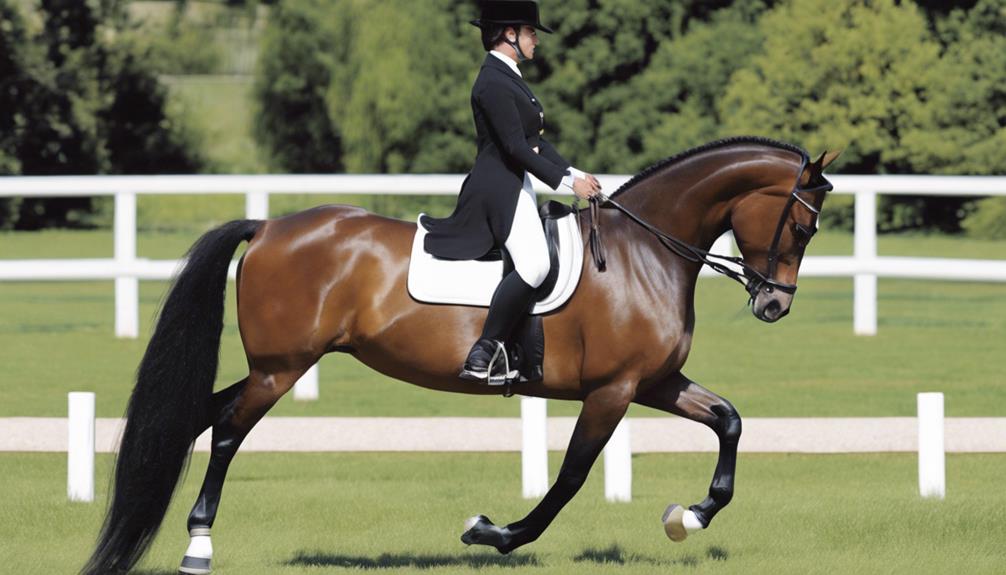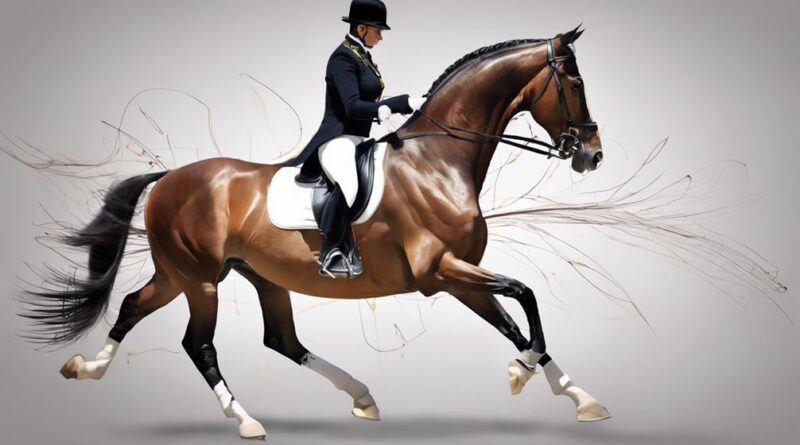Why Does Equine Biomechanics Impact Dressage Performance?
When you watch a skilled dressage performance, the harmony between horse and rider seems almost magical. But have you ever wondered why equine biomechanics play such a crucial role in achieving that level of excellence?
Understanding how the intricate movements of a horse are influenced by its biomechanics can unravel the secrets behind what makes a dressage performance truly exceptional.
As you explore this connection, you'll discover the intricate interplay between a horse's biomechanics and its ability to execute movements with grace and precision, shedding light on the path to achieving higher levels of performance.
Importance of Understanding Biomechanics
To truly excel in dressage performance, you must grasp the importance of understanding equine biomechanics. Biomechanics research and advanced training techniques have revealed that a horse's movement is intricately linked to its biomechanics. By delving into biomechanics, you can unlock the key to enhancing your horse's performance and overall well-being.
Biomechanics play a crucial role in rider communication. When you understand how a horse's body moves and functions, you can better communicate your cues effectively. Through biomechanics, you can learn how to apply subtle aids that align with your horse's natural movement patterns, ultimately leading to improved harmony and precision in your dressage performance.
Key Elements of Equine Biomechanics
Understanding the key elements of equine biomechanics is crucial for optimizing your horse's performance in dressage. By delving into biomechanics analysis, you can gain valuable insights into how your horse moves and how different training techniques can enhance its performance.
Biomechanics analysis involves studying how the different parts of your horse's body work together to produce movement. This includes examining factors such as stride length, joint angles, and muscle activation patterns. By understanding these elements, you can identify areas where your horse may have limitations or weaknesses that could be affecting its performance in dressage.
Training techniques play a significant role in improving your horse's biomechanics and, consequently, its dressage performance. Through targeted exercises and drills, you can help your horse develop strength, flexibility, and coordination. For example, exercises that focus on engaging the hindquarters can help improve impulsion and collection, key aspects of dressage movements.
Incorporating biomechanics principles into your training regimen can lead to more efficient movement patterns and better overall performance from your horse. By working with your horse's natural biomechanics and using appropriate training techniques, you can enhance its abilities and reach its full potential in dressage competitions.
Effect of Biomechanics on Movements
Exploring how biomechanics influences movements in dressage horses reveals crucial insights for optimizing performance and enhancing training techniques. When considering the effect of biomechanics on movements, factors like stride length and joint angles play a pivotal role in shaping the horse's performance. Here's how these biomechanical elements impact your horse's movements:
- Stride Length: Understanding how biomechanics affects stride length can help you improve your horse's efficiency and overall movement quality. By focusing on optimizing stride length through proper training techniques, you can enhance your horse's performance in various dressage movements.
- Joint Angles: The angles at which your horse's joints move significantly influence their ability to perform different dressage movements with grace and precision. By paying attention to joint angles and ensuring proper muscle activation, you can help your horse move more effectively and comfortably.
- Muscle Activation and Balance Cues: Proper muscle activation and balance cues are essential for achieving fluid and controlled movements in dressage. By incorporating biomechanical principles that emphasize muscle engagement and balance, you can enhance your horse's responsiveness and overall performance in training and competitions.
Relationship Between Biomechanics and Collection
Considering how biomechanics influences movements in dressage horses, an essential aspect to explore is the relationship between biomechanics and collection. Collection dynamics are profoundly impacted by the biomechanics of a horse. When a horse achieves biomechanical balance, it directly influences the effectiveness of collection.
Biomechanics plays a crucial role in collection dynamics, which refers to the horse's ability to bring its hindquarters more underneath its body, lightening the forehand. The biomechanics influence how well a horse can engage its hind end, lift its back, and flex its joints to achieve collection. A horse with good biomechanical balance can more easily maintain the necessary frame and impulsion required for collection.
In dressage, collection is a fundamental component of advanced movements. It requires the horse to shift its weight back, engage its hindquarters, and flex its joints to create a rounded frame. The biomechanics of the horse determine how effectively it can execute these movements. A horse with poor biomechanical balance may struggle to achieve proper collection, leading to issues with balance, impulsion, and overall performance.
Understanding the relationship between biomechanics and collection is vital for dressage riders and trainers. By focusing on improving the horse's biomechanics through proper training and exercises, riders can enhance the horse's collection effectiveness, leading to better performance in the dressage arena.
Impact of Biomechanics on Engagement
The efficiency of a horse's engagement in dressage movements is directly influenced by its biomechanics. When a horse is well-balanced and engaged, its performance can reach new heights. Here's how biomechanics impacts engagement and balance in dressage:
- Enhanced Connection: Proper engagement allows the horse to connect with the rider's aids more effectively. This connection fosters trust and communication between horse and rider, leading to a harmonious partnership in the ring.
- Improved Impulsion: Biomechanics plays a crucial role in generating impulsion, a key component of engaging movements in dressage. A well-balanced horse can channel its energy efficiently, creating powerful and expressive strides that captivate judges and spectators alike.
- Increased Collection: Balance is essential for achieving collection, a pinnacle of dressage performance. Through proper biomechanics, a horse can collect its body weight, elevate its forehand, and engage its hindquarters, showcasing elegance and grace in intricate movements like pirouettes and piaffe.
Role of Biomechanics in Extension
In achieving optimal extension in dressage performance, understanding the role of biomechanics is essential for both horse and rider. Extension biomechanics play a crucial role in the ability to perform extended movements with grace and power. Biomechanics research and performance analysis have shown that proper extension is achieved when the horse can lengthen its stride while maintaining balance and engagement.
To enhance extension biomechanics, specific training techniques are employed. Riders focus on engaging the horse's hindquarters to generate power and impulsion necessary for extended gaits. Through exercises such as shoulder-in and leg-yielding, riders can improve the horse's flexibility and strength, enabling them to execute extended movements with greater ease.
Biomechanics research has highlighted the importance of alignment and balance in achieving optimal extension. When the horse is correctly aligned and balanced, the energy generated from the hindquarters can flow through the horse's body, allowing for fluid and extended movements. Riders must pay attention to their position and aids to ensure they aren't impeding the horse's natural movement patterns.
Biomechanical Considerations for Half-pass

Understanding how biomechanics influence the execution of half-pass movements is crucial for enhancing your dressage performance. When performing half-pass exercises, consider the following biomechanical aspects:
- Lateral Bend: Achieving the correct lateral bend in your horse's body is essential for a successful half-pass. The horse's spine should bend in the direction of travel, allowing for smooth and effortless sideways movement. Focus on maintaining a consistent and even bend throughout the entire length of the horse's body to facilitate proper alignment and balance during the half-pass.
- Hindquarters Engagement: Engaging the hindquarters is key to executing a powerful and controlled half-pass. The horse's hind legs should actively step under its body, providing the necessary impulsion and strength to carry out the diagonal movement with ease. By promoting hindquarters engagement through effective aids and rider position, you can enhance the quality and expression of the half-pass.
- Shoulder Freedom and Diagonal Balance: Ensuring your horse has freedom in the shoulders is vital for allowing smooth and uninhibited movement during the half-pass. Encourage your horse to reach forward and across with its front legs while maintaining balance on the diagonal line. Strive for a harmonious coordination between the shoulders and hindquarters to achieve grace and precision in your half-pass performance.
Enhancing Performance Through Biomechanics
To optimize your dressage performance, utilize biomechanical principles to enhance your movements and overall execution. Training techniques play a crucial role in improving your performance. Incorporate exercises that focus on strengthening core muscles, improving flexibility, and enhancing coordination. By engaging in targeted physical conditioning routines, you can develop the strength and agility required for executing precise dressage movements with ease.
Rider position is another key aspect that significantly influences performance. Ensure that your posture is aligned correctly, with your shoulders back, heels down, and a straight back. Maintaining proper alignment not only improves your balance but also allows for better communication with your horse during maneuvers.
Additionally, equipment optimization is essential for maximizing performance. Invest in quality gear that fits both you and your horse comfortably. Ill-fitting tack can hinder movement and cause discomfort, ultimately impacting your overall performance.
Frequently Asked Questions
Can a Horse's Biomechanics Be Improved Through Training and Conditioning?
Yes, your horse's biomechanics can be improved through training and conditioning. Strength training and flexibility exercises are key to enhancing your horse's performance.
By incorporating these elements into your training regimen, you can help your horse develop better balance, coordination, and overall movement.
Consistent training and conditioning won't only improve your horse's biomechanics but also contribute to their overall well-being and success in dressage.
How Does a Rider's Biomechanics Influence a Horse's Performance in Dressage?
Your rider position and core strength directly impact your horse's balance and rein contact in dressage.
By maintaining proper alignment and engaging your core muscles, you provide clear and consistent cues to your horse, helping them move more efficiently and effectively.
Your biomechanics influence how well your horse can perform intricate movements, showcasing the importance of a harmonious partnership between rider and horse in dressage.
Are There Specific Exercises or Techniques to Address Biomechanical Issues in Horses?
To address biomechanical issues in horses, it is important to incorporate groundwork exercises and biomechanical analysis. Utilize manual therapy and biomechanical training techniques that are tailored to your horse's specific needs. These exercises and techniques can help improve your horse's movement, flexibility, and overall performance in dressage.
What Role Does Conformation Play in a Horse's Biomechanics and Dressage Performance?
When it comes to a horse's biomechanics and dressage performance, conformation plays a crucial role. Proper conformation can positively impact how the horse moves and performs in dressage.
Training techniques tailored to address conformational issues can help improve the horse's movement and overall performance in the discipline.
How Do Different Surfaces, Such as Arena Footing, Impact a Horse's Biomechanics During Training and Competition?
When you ride on different surfaces, like arena footing, your horse's biomechanics are directly affected. The impact of the footing can influence your horse's movements, stride length, and overall performance.
Biomechanics research and surface analysis play a crucial role in understanding how to adjust training strategies to optimize your horse's performance based on the specific footing conditions.
It's essential to consider these factors to ensure your horse's well-being and success in training and competition.
Conclusion
So, now you understand why equine biomechanics is crucial for dressage performance.
By focusing on key elements like collection, engagement, and extension, you can enhance your horse's movements and overall performance.
With a solid understanding of biomechanics, you can work towards improving your dressage skills and achieving your goals in the arena.
Keep practicing and paying attention to your horse's biomechanics to unlock their full potential in dressage.
